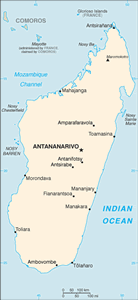The Geography of Madagascar
The Geography of Madagascar
Malagasy Geography
Location: Southern Africa, island in the Indian Ocean, east of Mozambique
Geographic coordinates: 20 00 S, 47 00 E
Map references: Africa
Area: total: 587,040 sq km land: 581,540 sq km water: 5,500 sq km
Area - comparative: slightly less than twice the size of Arizona
Land boundaries: 0 km
Coastline: 4,828 km
Maritime claims: territorial sea: 12 nm contiguous zone: 24 nm exclusive economic zone: 200 nm continental shelf: 200 nm or 100 nm from the 2,500-m isobath
Climate: tropical along coast, temperate inland, arid in south
Terrain: narrow coastal plain, high plateau and mountains in center
Elevation extremes: lowest point: Indian Ocean 0 m highest point: Maromokotro 2,876 m
Natural resources: graphite, chromite, coal, bauxite, salt, quartz, tar sands, semiprecious stones, mica, fish, hydropower
Land use: arable land: 5.03% permanent crops: 1.02% other: 93.95% (2005)
Irrigated land: 10,860 sq km (2003)
Natural hazards: periodic cyclones; drought; and locust infestation
Environment - current issues: soil erosion results from deforestation and overgrazing; desertification; surface water contaminated with raw sewage and other organic wastes; several endangered species of flora and fauna unique to the island
Environment - international agreements: party to: Biodiversity, Climate Change, Climate Change-Kyoto Protocol, Desertification, Endangered Species, Hazardous Wastes, Law of the Sea, Marine Life Conservation, Ozone Layer Protection, Ship Pollution, Wetlands signed, but not ratified: none of the selected agreements
Geography - note: world's fourth-largest island; strategic location along Mozambique Channel


